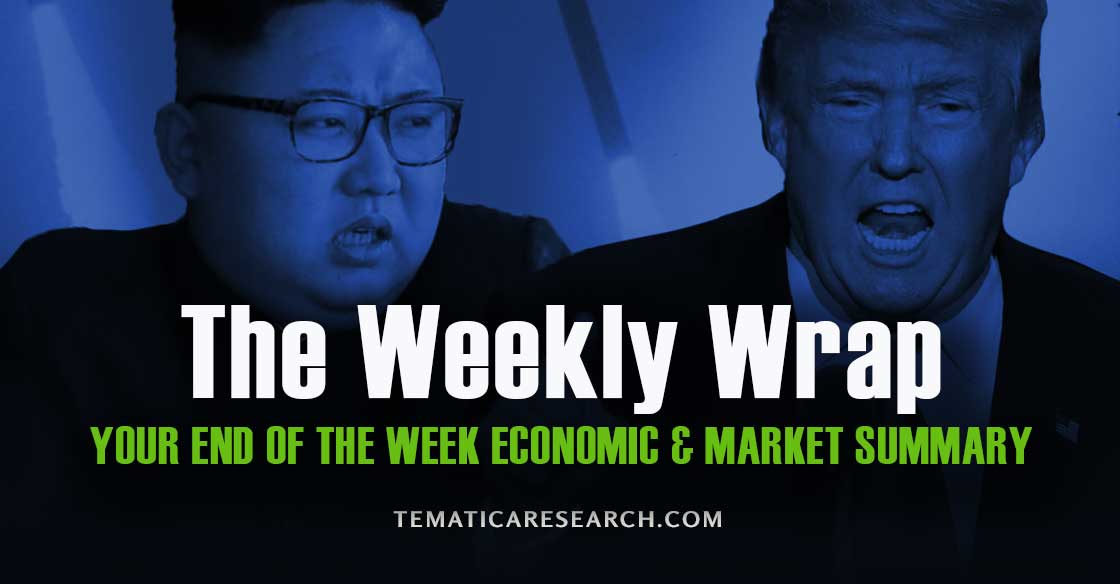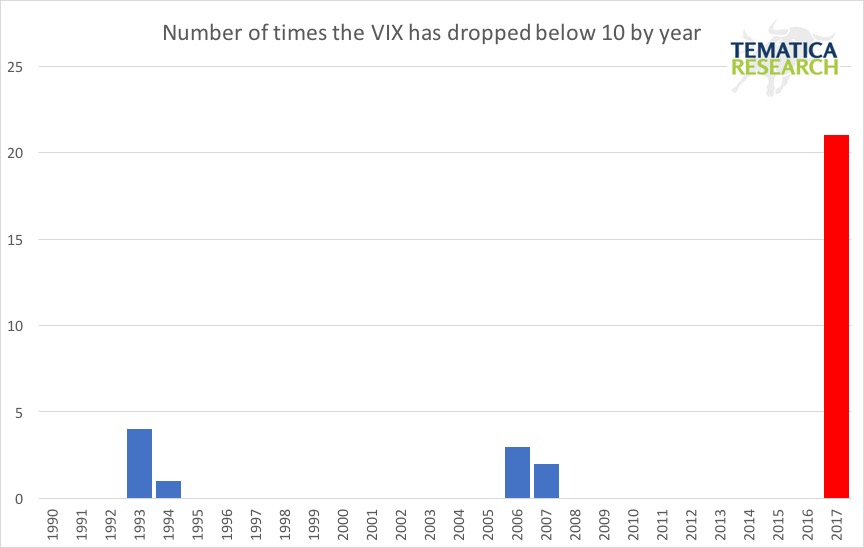Another Week of the Market Brushing Off Uncertainty Amid Political Turbulence and Less Than Rosy Data
While the president and “Rocket Man” trade barbs, Iranian President Said stated that Iran would continue with its missile program in defiance of U.S. sanctions, unveiling its latest long-rage ballistic missile at a parade in Tehran. In response, the CBOE S&P 500 Volatility Index (VIX) briefly rose all the way to the veritable nosebleed territory of nearly 10.20 during Friday’s trading.
So that looks utterly insane normal. Over the past 18 years, the VIX has closed below 10 all of 31 times, with 21 of those in 2017. Yup, that’s 68% of the instances in 2017 alone. When one considers the potential if reversion to the mean holds, one might desire a stiff drink. (As a side note I have unfortunately discovered the joy of Johnnie Walker Blue thanks to the British Airways lounge in London and once having tasted the nectar of the gods…)
Someone might want to send a bottle of Johnnie Walker to Tim Cook this afternoon if Google search trends comparing iPhone 7 to 8 (hat tip Bespoke Research) and the rumors of the reception in China, Australia, and apparently all over the place are an indication of what’s to come.
A Look Back at the Market This Week
After having broken to new all-time highs last week, the S&P 500 closed this week mostly flat at 19x expected 2017 earnings – that’s head and shoulders above the 5 and 10-year average (there is that darn reversion to the mean risk popping up again.) Looking at the market internals, sector rotation has been more active, with Utilities and Healthcare taking a back seat while Energy, Financials and Industrials take the lead. Utilities, which had been the strongest sector from early July through early September has now dropped below its 50-day moving average. Healthcare, one of the strongest performers earlier in the year, has been consistently sliding since September 11th. In a move that seems rather consistent with much of the market these days, the Russell 2000 has been stretching up to new highs, while 2017 EPS expectations drop to the lowest level of the year, naturally.
The market interpreted Wednesday’s release of the FOMC minutes as more hawkish than expected, which pushed the dollar to peak above its downtrend. Keep in mind, the decline in the dollar this year has been the worst since the Plaza Accord, which was the time that a big group of central bankers got together to bust the greenback’s back, so this decline has been noteworthy. This recent breakout for the dollar is worth watching as it could indicate a change in the trend.
The 10-year Treasury yield also broke out above the downtrend we’ve seen post-election 2016. While we see formidable headwinds to any meaningful and lasting increase in long-term rates, this is another move that bears watching. Our full perspective on the Fed and its “strategery” can be found here, and for more Tematica insight on what it means, tune into this week’s Cocktail Investing Podcast.
Pouring Through the Week’s Economic Data
The Bureau of Labor Statistics report on Tuesday for US import and exports likely gave the Fed some comfort as durable import prices are starting to tick up and capital good prices are up year-over-year for the first time since 2012. Core export prices are also showing some upward pressure.
Wednesday also saw disappointing home sales, with the percentage of ever-important first-time home buyers down to 31% of sales, the lowest level in a year. Existing home sales declined 1.7% in August after a 1.3% drop in July. Activity has now been down for 3 consecutive months and down 4 out of the past 5. The number of existing homes sold in August on an annualized basis represents a new 12-month low and since January, resales have fallen at a 10% annualized pace. Inventory remains tight, with August’s months’ supply number the lowest for an August. With such tight supply, the median national existing home sales price reach a record for the month and is continuing to show consistent appreciation. While not good for the Cash-Strapped Consumer that is looking to dip into the housing market for the first time, it likely means rental demand will remain robust.
On the other hand, Tuesday’s housing construction numbers from the Census Bureau painted a more mixed picture with Building Permits coming in 7.3% above expectations while Starts were just a tad above expectations. Combined, these two hit the strongest level since June of 2015, which is a promising sign for housing. With the Fed targeting several rate increases before the end of 2018, we’ll see if this gets potential buyers off the fence before mortgage rates move higher.
Thursday was a decidedly upbeat day on the economic front with the Philly Fed Manufacturing Index delivering better-than-expected numbers after having declines for three consecutive months. The internals were robust as well with seven of the nine components showing sequential increases, the two employment-related measures were the only ones in the red. Jobless claims came in below expectations, extending the streak of sub-300k readings to 133 weeks. We suspect we’ll see a jump up in the coming weeks due to the weather devastation in the South. We wrapped up with week with mixed data from the preliminary September US PMIs. Services came in materially below expectations while Manufacturing moved minutely higher as New Orders grew at the slowest rate in the past 12 months. Now to wait for the rash of September data that will put the hurricane influence on the economy into perspective.
Putting it All Together
This week continued the trend of rosier sentiment reports than the hard data would imply and a market that doesn’t seem to want to sweat much of anything. While more and more are joining the chorus of, “Something doesn’t smell quite right,” in the markets, a full bear market is unlikely to materialize outside of a recession. While the hard economic data doesn’t have us toasting with the bubbly, it isn’t painting imminent despair either. As the meh-ness of it all continues, finding those areas that have profound tailwinds becomes increasingly important and we happen to be laser focused on just that with our investing themes.
Wishing you all a wonderful weekend and hoping that somebody gives Mother Nature a big hug, some warm cocoa or perhaps a puppy so that she will chill out for a few weeks!




